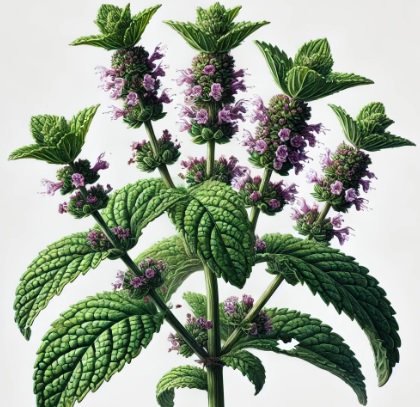Mentha Canadensis, also known as Canadian Mint, is a plant belonging to the Lamiaceae family. It is valued for its aromatic and medicinal properties, often used in traditional and modern applications for its distinctive minty fragrance and potential benefits.
Chemical Composition and Structure:
Menthol: Contributes a cooling sensation and minty aroma.
Carvone: Adds a characteristic mint scent.
Limonene: Imparts citrus notes to the overall aroma.
Other Terpenes and Essential Oils: Various compounds that enhance the aroma and therapeutic properties of the plant.
Physical Properties:
Appearance: Typically a herbaceous plant with green leaves and small, often purple or white, flowers.
Odor: Fresh, minty, and herbaceous aroma.
Solubility: Essential oils and extracts are soluble in oils and alcohol; generally not soluble in water.
Production Process:
Cultivation: Mentha Canadensis is grown under optimal conditions to produce high-quality foliage.
Harvesting: Leaves and flowering parts are collected when they reach peak aromatic quality.
Extraction: Essential oils or extracts are obtained using methods such as steam distillation or solvent extraction to isolate the active compounds.
Formulation: Extracts and oils are integrated into various products, including cosmetics, personal care items, and therapeutic formulations.
Applications:
Cosmetics and Skincare: Utilized in creams, lotions, and serums for its refreshing and aromatic properties.
Hair Care: Included in shampoos and conditioners for its revitalizing and invigorating effects.
Aromatherapy: Employed in diffusers and blends for its stimulating and soothing aroma.
Environmental and Safety Considerations:
Environmental Impact: Sustainable cultivation and extraction practices are crucial to minimize the environmental impact and ensure the quality of the plant material.
Safety: Generally considered safe for use. As with all plant-based ingredients, individual sensitivities or allergic reactions may occur.
INCI:
Humectant. Hygroscopic compound used to minimise water loss in the skin and to prevent it from drying out by facilitating faster and greater absorption of water into the stratum corneum of the epidermis. The epidermis is the most superficial of the three layers that make up human skin (epidermis, dermis and hypodermis) and is the layer that maintains hydration in all three layers. In turn, the epidermis is composed of five layers: horny, the most superficial, granular, spinous, shiny, and basal. Humectants have the ability to retain the water they attract from the air in the stratum corneum and have the function of moisturising the skin. They are best used before emollients, which are oil-based.
Skin conditioning agent. It is the mainstay of topical skin treatment as it has the function of restoring, increasing or improving skin tolerance to external factors, including melanocyte tolerance. The most important function of the conditioning agent is to prevent skin dehydration, but the subject is rather complex and involves emollients and humectants that can be added in the formulation.
Synonyms:
CAS:
![]() Mentha Canadensis
Mentha Canadensis 

